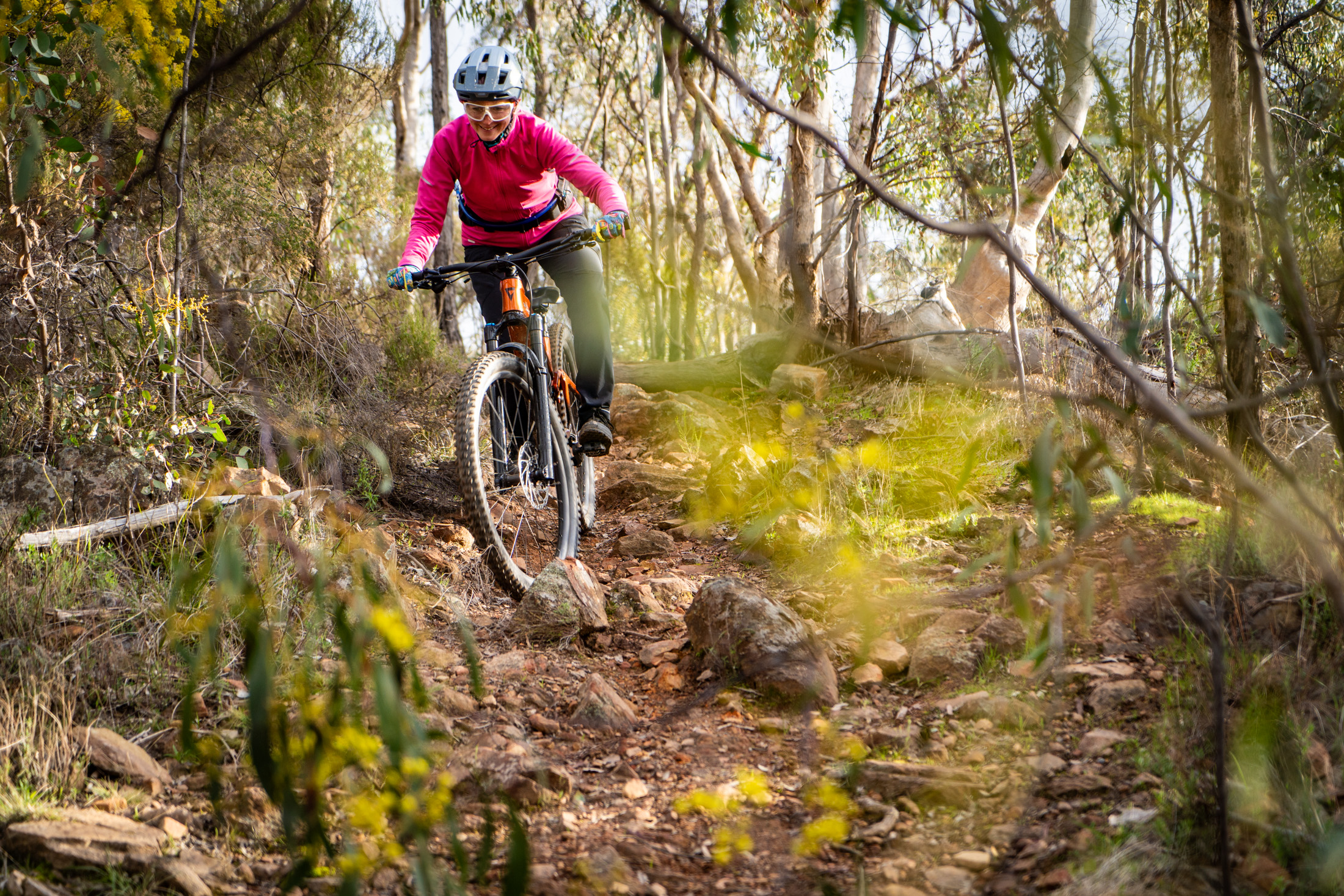Buying your first electric mountain bike can be quite an intimidating process. Not only do you have to contend with a sea of different bike brands, there’s a huge variance in prices from the cheapest through to the most expensive options. How much money do you actually need to spend to get a decent e-MTB that’s going to stand up to proper trail riding? Should it be carbon or alloy? Is longer travel better? And what the heck are mullet wheels?
Then there’s the motor and battery system. Bosch, Shimano, TQ, Fazua, Yamaha. Do you want the most power possible? Or do you prefer a more subtle level of assistance from a smaller and quieter motor? How big of a battery do you need? Nobody wants to run out of juice in the middle of a ride, so making sure you get the right amount of assistance for your needs is an important consideration.
Over the past few years we’ve reviewed a tonne of e-MTBs here at Flow. We know what works well, what doesn’t work so well, and why you’d pick one bike over countless alternatives. To help you make that choice, these are the most important aspects to weigh up when buying your first e-MTB.
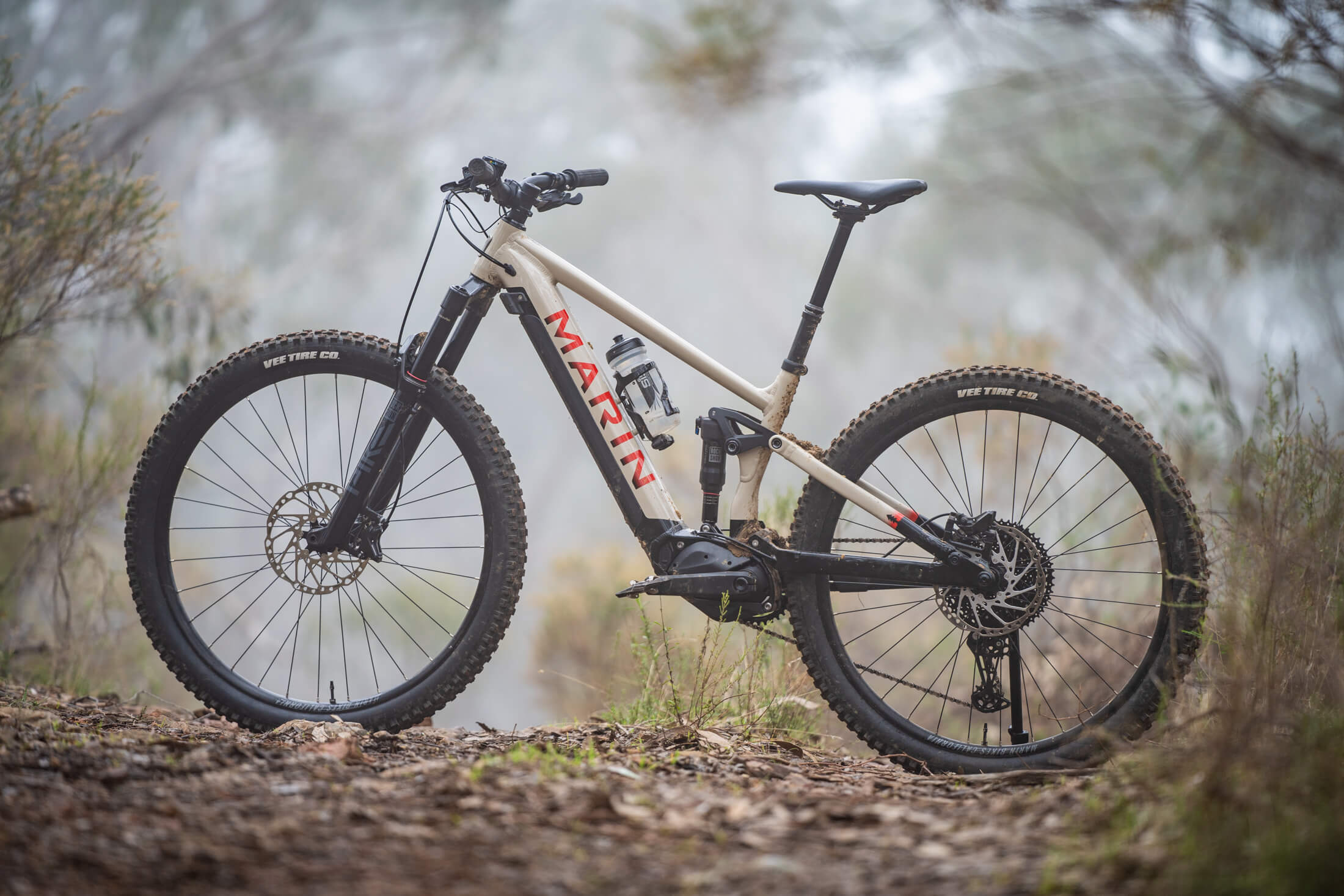
Price | How much should you spend on an e-MTB?
Firstly, you’ll need to define your budget.
At the cheaper end of the market you’ll be able to find hardtails and basic full suspension bikes for under $6,000 AUD. And if you’re only riding recreationally on bike paths, rail trails and smooth dirt roads, then it’s likely that you won’t need to spend any more than that. But if you’re after a bike for proper off-road riding on dedicated singletrack, you’ll need to seriously consider the next price range up.
To give you an idea of what’s available, here are the prices of six e-MTBs that we’ve tested recently;
- Polygon Siskiu T7E – $6,599 AUD
- Marin Rift Zone E1 – $7,499 AUD
- Giant Trance X E+ Elite – $9,499 AUD
- Husqvarna MC 6 – $12,499 AUD
- Orbea Wild M10 – $15,499 AUD
- Specialized Levo Pro – $21,000 AUD

As you can see, there’s a considerable difference in price between the cheapest and most expensive options in that list. So what exactly are you getting for the extra money?
A higher price will typically translate to a more premium frame construction and higher spec components. You’ll be getting better quality suspension, stronger brakes and tougher tyres. You’ll also see the use of exotic materials like carbon fibre, which usually results in a lighter overall bike weight.
Though not always the case, you may get a better and more powerful motor as you go up the range. Higher-end models can sometimes come with bigger batteries too, and some even include an additional range extender battery.
How you buy your bike will also dictate the price. Purchasing online can often result in a lower cost compared to buying from a local shop, though the level of service can vary quite a lot between those two options. We’ll discuss that in more detail shortly.
Of course everyone’s budget and perception of value is different, but from our experience it’s the $7-9K price bracket where you’ll start to encounter really good quality e-MTBs. Brands such as Merida, Norco, Giant and Marin offer some top-notch bikes in this range, and are well worth looking at if you’re after your first proper e-MTB.

Suspension & riding style
As with regular mountain bikes, how much suspension travel an e-MTB has will play a big role in how it rides and what terrain it’s best suited to.
For this discussion we’ll mostly be focussing on full suspension bikes. Of course it is possible to get a hardtail e-MTB, but in all honesty it’s not the best riding experience if you’re venturing onto rougher and more technical trails. While it is great to have a suspension fork up front, the added weight of the motor and battery means the rear wheel slams into objects a lot harder. You have to run higher tyre pressures to avoid punctures, making the ride even firmer.
As such, we’d always recommend looking towards a full suspension e-MTB, even for recreational riders. You’ll enjoy a vastly more comfortable ride, along with greater grip and control when taking on singletrack.
When it comes to full suspension e-MTBs, the amount of travel helps to indicate what kind of riding that bike is designed for. Although there are some exceptions that blur the boundaries, we can group most e-MTBs into four basic categories;
- XC/Trail – Up to 140mm of travel
- All Mountain – 140-160mm of travel
- Enduro – 160-180mm of travel
- DH – >180mm of travel

Generally speaking, the more travel a bike has the more traction and stability you’ll have on rougher terrain. If you’re doing a lot of descending on rocky trails with lots of big jumps and drops along the way, you’ll typically want more suspension to provide grip and help soak up the landings.
There is an argument with e-MTBs that since you have a motor helping you up the hills, you might as well have as much travel as possible. If you’re the type that likes to wear a full-face helmet and body armour, and you view an e-MTB as a self-shuttling DH bike, then you’ll likely want to look at an e-MTB with upwards of 160mm of travel.
However, it is possible to have too much squish. Depending on the terrain, a shorter travel bike can be more lively and playful. They tend to be lighter, and therefore easier to manage when things get tight and twisty. For many riders an e-MTB is also about the uphill challenge. If you’re someone who wants to take on techy climbs as well as the descents, you might not necessarily want the heaviest and biggest travel bike out there.
As you’d expect, the most popular segment sits right in the middle. Bikes such as the Specialized Levo, Trek Rail and Merida eOne-Sixty feature 150-160mm of travel and are fantastic options for all-round riding.

Full-powered or lightweight e-MTB?
Once you’ve decided how much suspension you need, the next decision to face is whether to go for a full-powered or a lightweight e-MTB.
Full-powered is the more traditional offering, and the concept is relatively straightforward. These bikes use larger and more powerful motors, typically with 85-90Nm of torque, and they incorporate a bigger battery of around 700-900Wh to maximise range. While they are heavier and bulkier, full-powered e-MTBs offer a lot more support to get you up climbs faster and with less effort. They’re a great option if you’re not particularly fit, as the motor can do most of the work for you. They’re also the best tool for the job if you’re riding a lot of big mountains and you want to squeeze as much riding into the day as possible.
- Motor – 75-108Nm of peak torque
- Battery – 630-900Wh
- Bike Weight – 21-26kg
- Examples – Specialized Levo, Trek Rail, Orbea Wild

Lightweight e-MTBs are newer to the scene and take a slightly different approach. These bikes offer a more subtle level of assistance that aims to enhance your own leg power, rather than dominate the riding experience. The motors are more compact and produce less overall power with peak torque outputs of less than 60Nm. Because the motors aren’t as thirsty they can be paired with a smaller 320-430Wh battery, which allows the frame design to be much sleeker. As a result, the overall bike weight ends up being around 4-6kg lighter than an equivalent full-powered e-MTB, making them more agile and playful. However, you generally need to be a fitter rider to get the most out of a lightweight e-MTB. And if you’re doing a lot of climbing and use the motor in its most powerful setting, it’s possible to drain the battery quite quickly. With this in mind, many brands offer optional range extender batteries.
- Motor – 35-60Nm of peak torque
- Battery – 320-430Wh
- Bike Weight – 16-20kg
- Examples – Specialized Levo SL, Trek Fuel EXe, Orbea Rise
Outside of the full-powered and lightweight e-MTB categories, there are some bikes that straddle the gap. One such example is the Giant Trance X E+ Elite, which pairs a full-powered motor with a 400Wh battery. It’s a curious combination that will work for some riders, but not for others.
We say this because when choosing between a full-powered and a lightweight e-MTB, it’s important to consider not only the terrain you’ll be riding, but also your weight. Heavier riders will typically require more assistance from the motor, and that’s going to drain the battery quicker. If you’re north of 90kg, we’d recommend looking towards a full-powered e-MTB with a decent size battery. Lighter and fitter riders will be able to get away with a smaller capacity battery, and therefore will be better suited to a lightweight e-MTB.
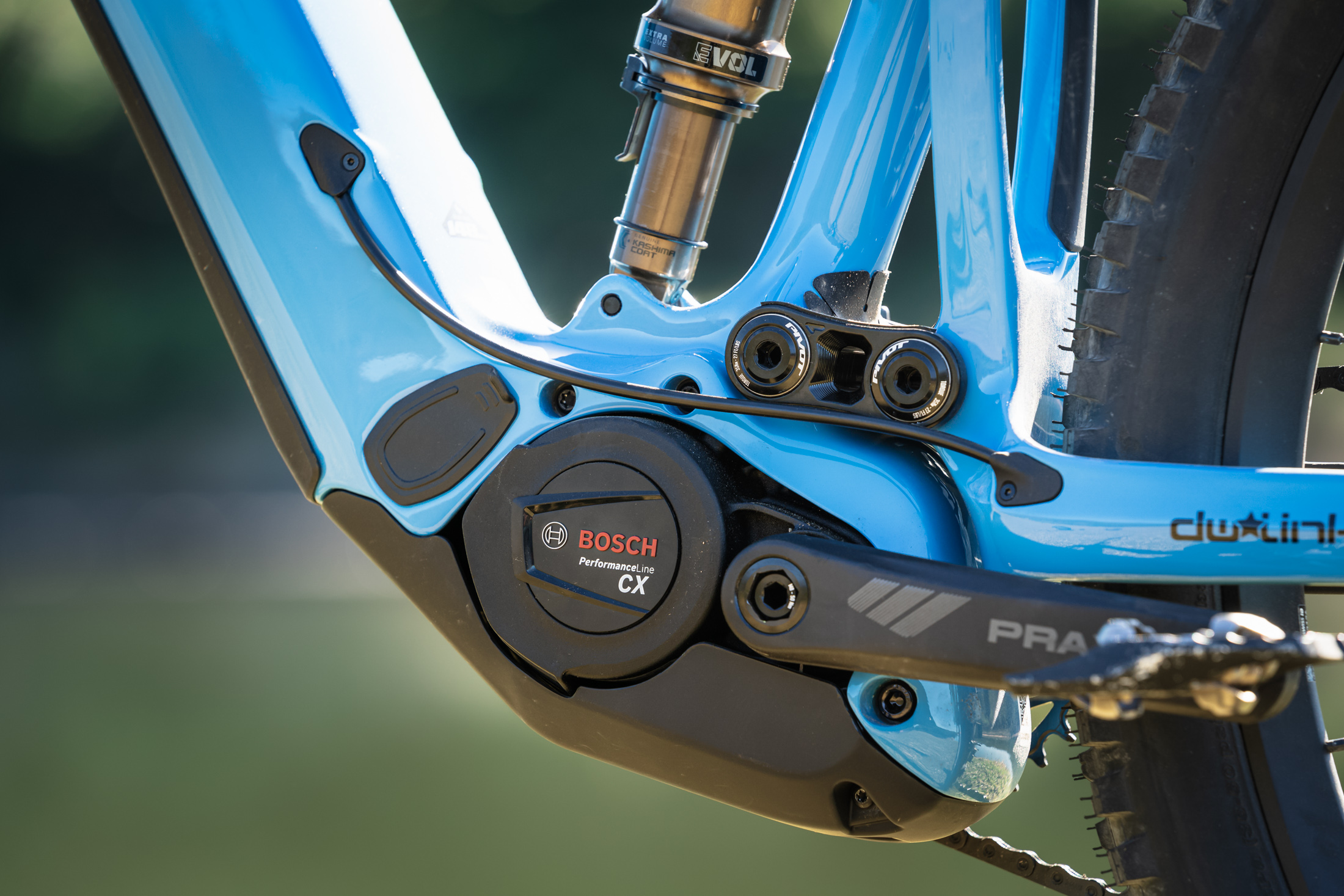
Motor | Power is nothing without control
The motor is obviously an integral part of any e-MTB. We wouldn’t necessarily buy a bike just for its motor, but it’s still an important consideration. That’s because it isn’t possible to swap between different drive units, so whatever your frame comes with is what you’ll be living with long-term.
There are a lot of options out there, including well-known motors from Bosch, Shimano, TQ, Fazua, Brose (Specialized), Yamaha (Giant), SRAM and Dyname. Some of those you’ll find used across numerous bike brands. That’s the case for Bosch, Shimano, TQ, SRAM and Fazua. Others are a more exclusive affair, like the Dyname motor that you’ll only find in Rocky Mountain e-MTBs.
Specialized takes a similarly tailored approach by using a Brose-manufactured motor in the Levo, and a Mahle-manufactured motor in the Levo SL. It differs from many of its competitors in that it also develops all of the firmware that drives the motors.
Confusing things, each motor brand typically offers more than one drive unit. Some are made for urban riding, and others are more specific to e-MTB use. For example, Shimano produces an EP6 and an EP801 motor, while Bosch produces no fewer than four different motors for e-MTBs.
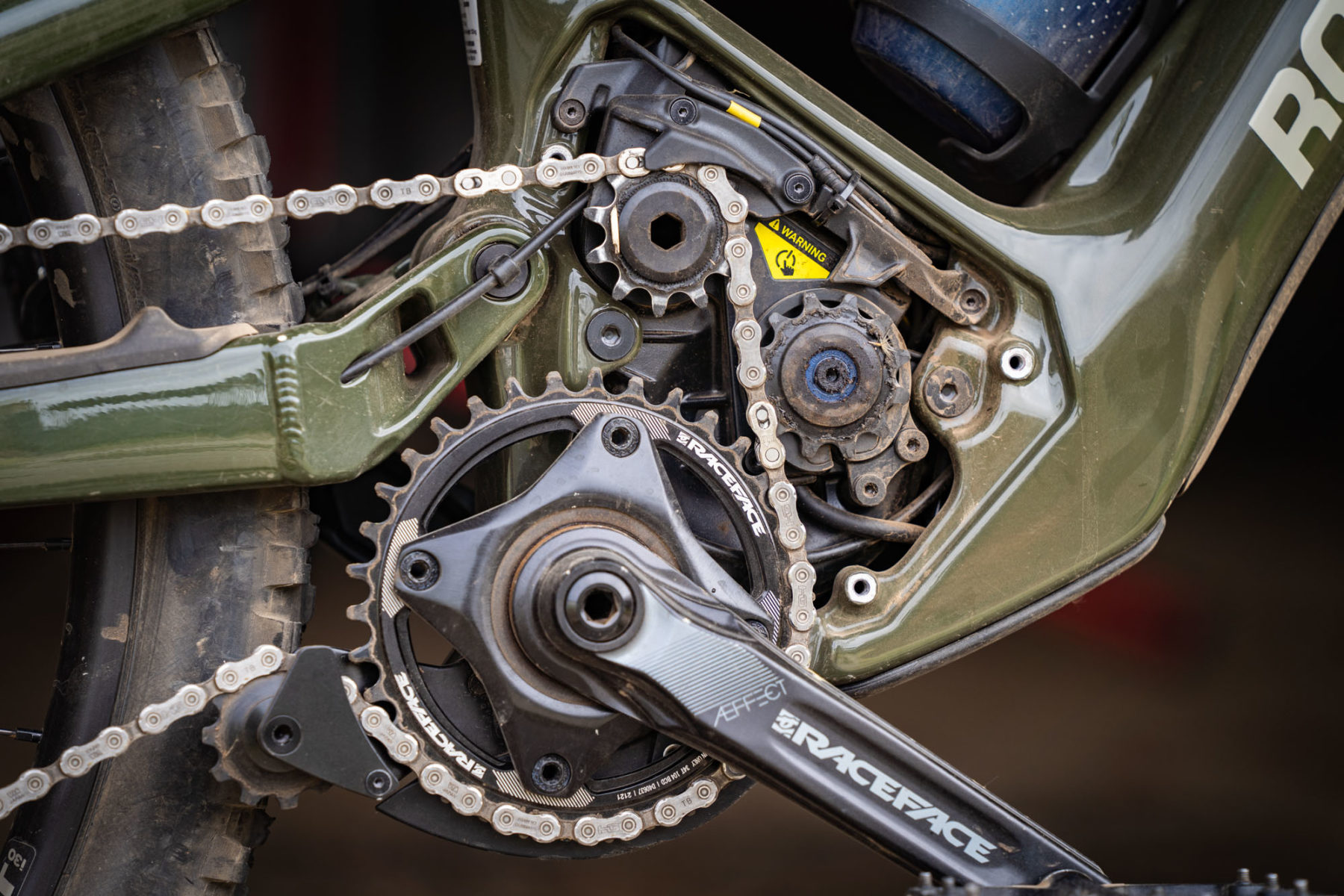
To help with understanding the differences, manufacturers will state the peak torque and power output for each of their motors. This will give you a relatively good understanding of how much grunt it’ll offer. However, we should point out here that since there’s no independent third party verifying these claims, you’re essentially taking each brand on its word.
That aside, here’s a brief overview of the claimed specs for some of the more popular motors on the market:
- Dyname 4.0 – 108Nm torque & 700W peak power
- SRAM Powertrain – 90Nm torque & 680W peak power
- Brose/Specialized 2.2 – 90Nm torque & 565W peak power
- Bosch Performance Line CX – 85Nm torque & 600W peak power
- Shimano EP801 – 85Nm torque & 600W peak power
- Yamaha/Giant SyncDrive Pro 2 – 85Nm torque & 500W peak power
- Fazua Ride 60 – 60Nm torque & 350W peak power
- Mahle/Specialized SL 1.2 – 50Nm torque & 320W peak power
- TQ HPR50 – 50Nm torque & 300W peak power
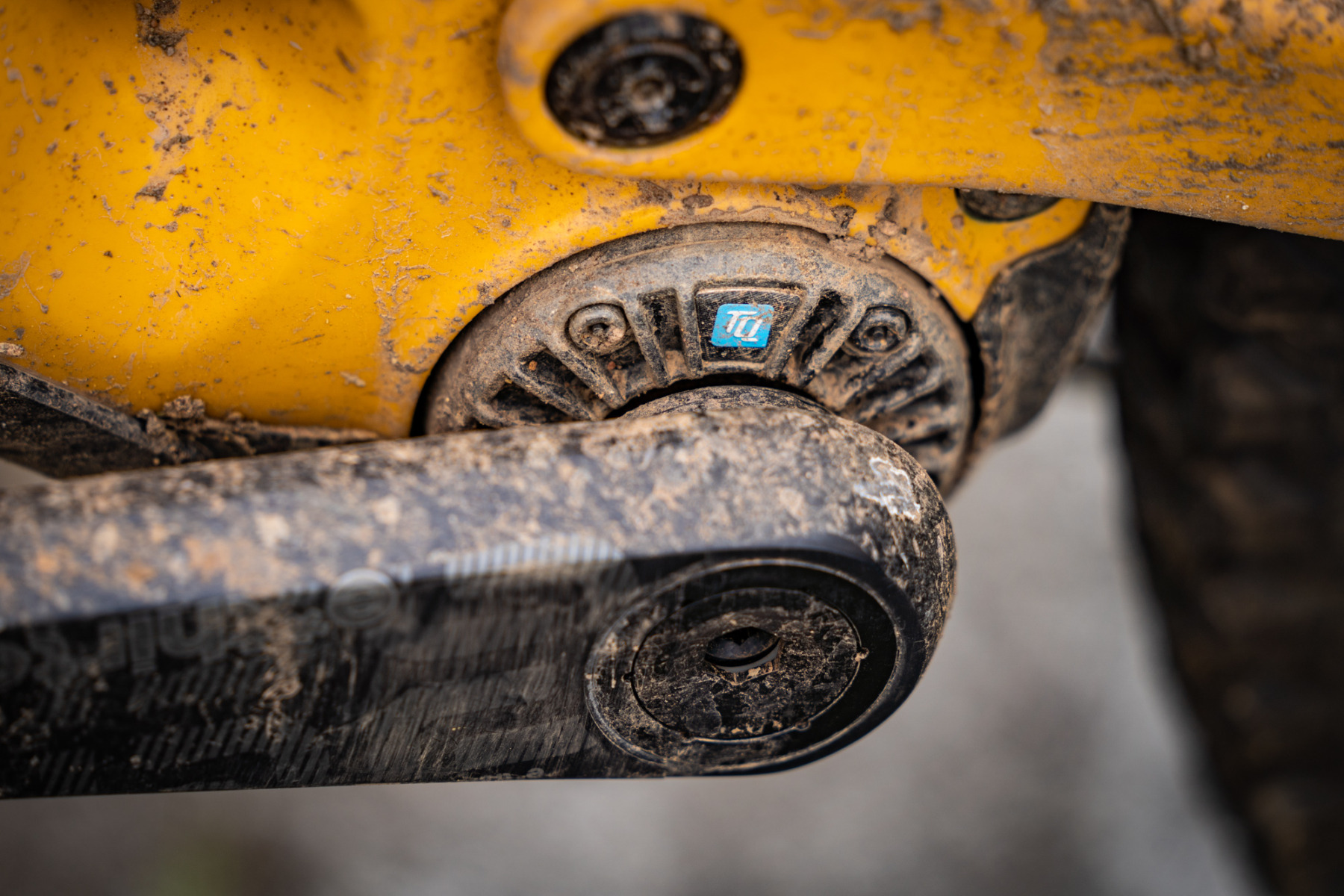
It’s important to understand that e-MTB motors are more than just some numbers in a spec sheet. Numerous sensors are employed to help the motor understand your riding speed, cadence, input torque and sometimes even the gradient of the trail you’re riding. The system takes this information and determines how to deliver its power output to the rear wheel. It’s this interaction between your legs and the motor that really determines how effective the support is out on the trail. You can have loads of power, but if it isn’t well-controlled then it can make the whole bike unwieldy on steep climbs and tight corners.
Fortunately a lot of modern e-MTB motors are getting very good in this regard. In particular, Bosch and Shimano both feature special adaptive modes that provide progressive assistance that’s directly proportional to how hard you’re pushing on the pedals. The result is a smoother and more intuitive feel to power delivery.
Additionally, each motor offers several different assistance levels that allows you to choose how much support you want. Some brands even provide you with the option to tune specific parameters, like how quickly the motor accelerates and how easily it reaches its peak power output. If you’re curious about what’s involved, check out our separate tuning tips articles for Bosch and Specialized motors.

Battery | Is bigger always better?
The battery is another key component of an e-MTB. It is specific to the motor it’s paired with, which means you can’t mix and match. If you have a Shimano motor then you need to use the specific Shimano battery. We’d love to see this change in the future with greater standardisation between the big brands, but that’s a separate discussion for another day.
e-MTB batteries are rated on their capacity, which is measured in watt-hours. The more cells a battery has, the more watt-hours it can provide. It’ll also be bigger and heavier. Here’s a quick look at three different battery sizes;
- Specialized Levo SL – 320Wh battery (1.8kg)
- Merida eOne-Sixty – 630Wh battery (3.7kg)
- Canyon Spectral:ON – 900Wh battery (4.78kg)
Put simply, the bigger the battery is the further you can ride. The downside is that these larger 700-900Wh batteries are heavier and longer. They put more mass up towards the head tube, which is generally not where you want it. While some riders like this added stability, it can lead to sluggish, front-heavy handling that makes it harder to get the wheels off the ground.
In comparison, a smaller 320-430Wh battery will be lighter and shorter. This helps to lower the bike’s overall centre of mass, which improves the handling and provides a more agile and playful ride quality. It also allows for a sleeker downtube that looks better and also means the frame can be made quite a bit lighter. The downside is that you won’t get as much range out of a smaller battery, especially if you’re using the higher assist modes.

Most e-MTBs are designed around a specific battery shape, so when you’re choosing the bike you’re locking yourself into that size. However, there are some exceptions. The Norco Sight VLT can be purchased with one of three different batteries (540, 720 and 900Wh), while the Canyon Spectral:ON gives you two options (720 or 900Wh). This means you could buy a bigger or smaller battery in the future if you found the stock option wasn’t meeting your riding demands.
Further flexibility is offered via range extender batteries. This is an option you’ll find with lightweight e-MTBs like the Levo SL and Trance X E+ Elite, which can accommodate an additional piggyback battery that sits in place of the bottle cage. These improve the bike’s versatility, though at around $1,000 AUD they don’t come cheap.
Another thing to consider is whether you need the battery to be easily removed from the frame. Bikes such as the Scott Patron and Husqvarna Mountain Cross use nifty trapdoor mechanisms that allow you to quickly remove the battery so that you can charge it in a separate location to where your bike is stored. For some owners this will be a crucial feature.
Other e-MTBs such as the Pivot Shuttle AM and Orbea Rise use a bolt-in battery. It can still be removed, but it usually requires you to drop out the motor so it’s a more complex and time-consuming process. As such, these bikes have charge ports integrated into the frame.
In our experience, we’ve found that a bolt-in battery tends to be more secure with less chance for vibration and rattling. It’s also advantageous from a structural perspective, as the downtube doesn’t need to have a whacking great hole cut into it. On the new Orbea Wild for example, moving to a fixed battery saw the frame weight drop by almost a kilo, while downtube stiffness increased by a claimed 52%.

Range | How far can you ride on an e-MTB?
One of the most common queries with each e-MTB we review is based around how far you can ride it on a single charge. Unfortunately the answer isn’t simple, since there are so many factors that determine what range you can achieve.
The most obvious one is the assist level that you choose to ride with. A higher setting will give you more support, but it’ll also drain the battery faster. If you want more range then you’ll need to make use of the lower assist modes.
Two other important variables are rider weight and elevation gain. If you’re a heavy rider that’s tackling big mountain climbs, you’re going to run the battery flat a lot quicker compared to a lighter rider who’s on flatter trails. Because of this, we tend to measure e-MTB range in elevation gain rather than distance, since it provides a more accurate representation for mountain biking.
How you ride also influences range. It’s a bit like driving a car, where you want to avoid excessive braking and rapid accelerations in order to maximise fuel efficiency. Ride with a steady cadence and you’ll eke more range out of your e-MTB’s battery. Of course this isn’t always possible, especially if you’re traversing technical and undulating terrain that requires significant changes in riding speed as you climb and descend. Rougher and looser trails will require more energy to conquer compared to pedalling along a smooth fireroad.
Tyre choice can have a big impact too. A heavier tyre casing with more aggressive tread and a stickier rubber can add considerable drag that’ll draw more power from the battery.
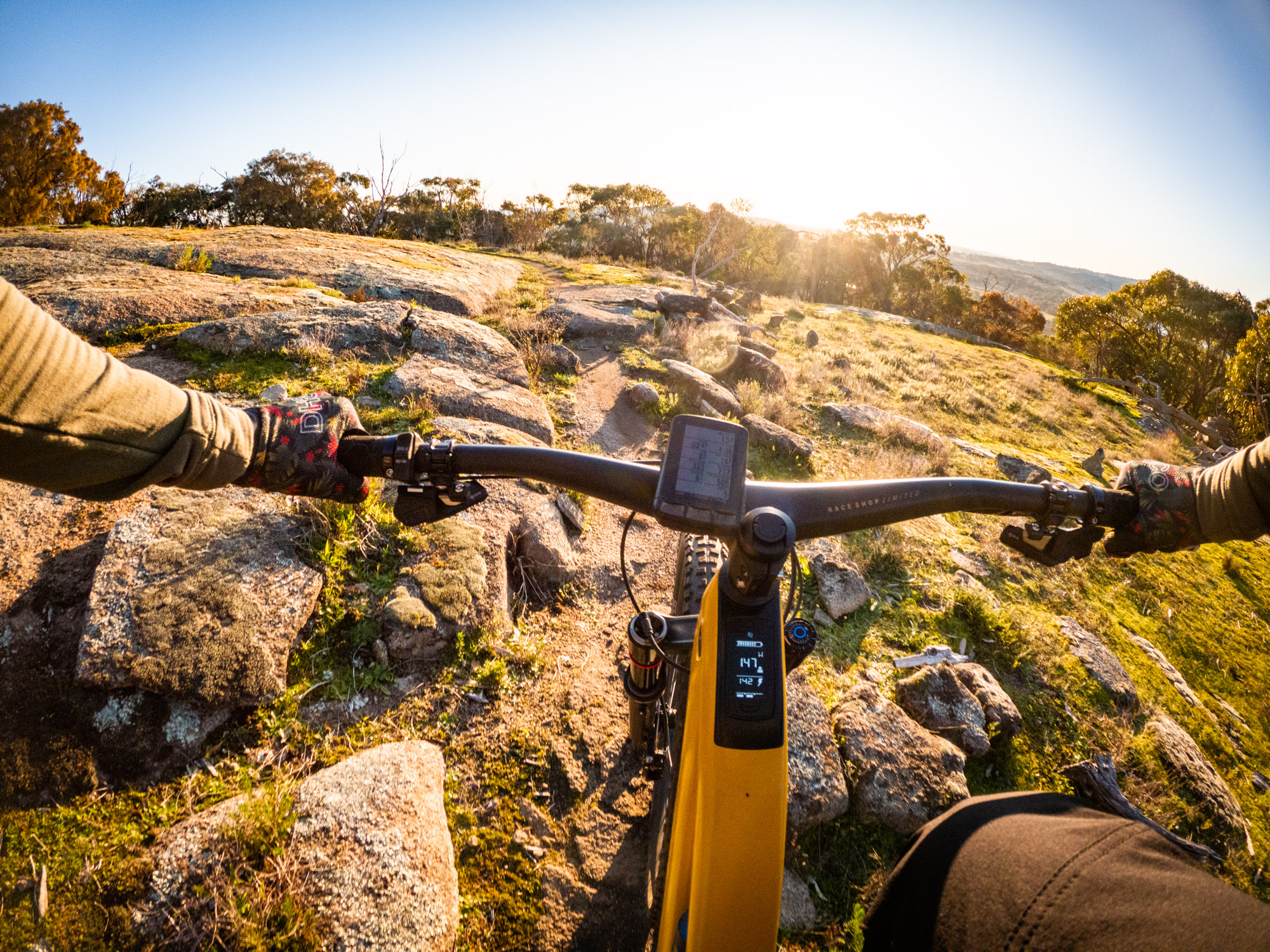
To help provide a number for their potential customers, some manufacturers will provide range estimations for their e-MTBs. Typically these are done in the most favourable conditions, and don’t always stipulate key details like rider weight and trail technicality. As such, it’s worth taking them with a grain of salt.
For our e-MTB reviews, we always like to produce our own data when it comes to range testing. Some of these tests are done on regular singletrack loops, though we also conduct a ‘standardised’ range test to provide a more accurate comparison between bikes. This involves climbing up a bitumen road climb before bombing down a singletrack descent, and repeating to see how many laps we can get in before the battery goes flat. It’s not a perfect test, but it keeps the variables to a minimum by setting the motor to its most powerful setting and using the same 68kg test rider and the same climb every time.
Here are the results from some of the e-MTBs we’ve tested, in order from the most range to the least;
- Norco Sight VLT (900Wh Battery) – 2,478m climbing
- Canyon Spectral:ON (900Wh Battery) – 2,451m climbing
- Cube Stereo Hybrid 160 (750Wh Battery) – 2,320m climbing
- Rocky Mountain Altitude (720Wh Battery) – 2,108m climbing
- Scott Patron (750Wh Battery) – 2,079m climbing
- Scott Lumen (360Wh Battery) – 1,567m climbing
- Orbea Rise (360Wh Battery) – 1,388m climbing
- Trek Fuel EXe (360Wh Battery) – 1,312m climbing
- Specialized Levo SL (320Wh Battery) – 1,307m climbing
- Giant Trance X Advanced E+ Elite (400Wh Battery) – 1,057m climbing
- Specialized Kenevo SL (320Wh Battery) – 1,053m climbing
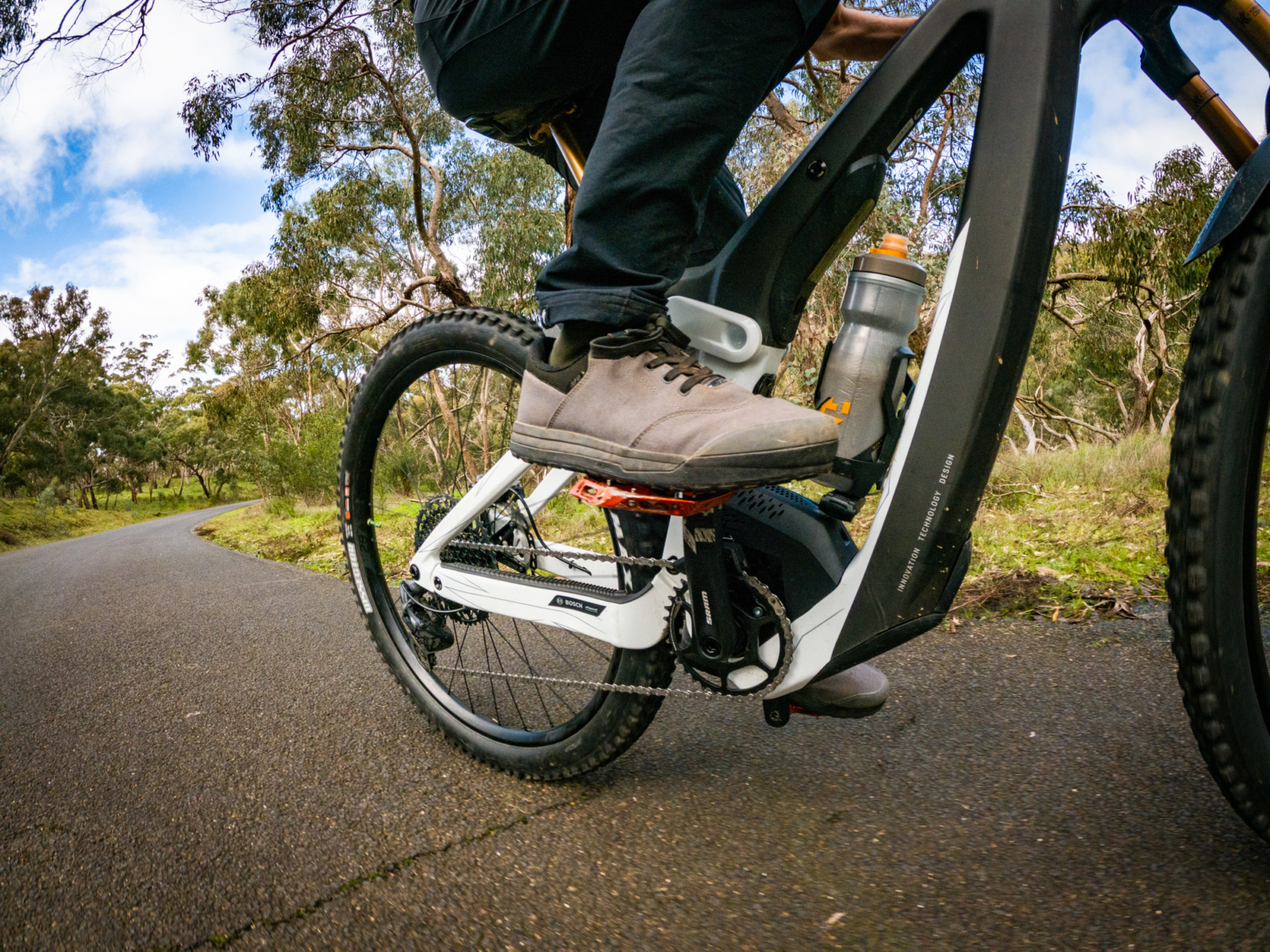
While the exact numbers from this range test won’t be applicable to every rider, it does provide a useful point of comparison. It also helps to show the difference in range capability between the full-powered e-MTBs (the top five) and the lightweight e-MTBs (the bottom six).
One metric that isn’t shown in the above data is riding speed. This is important when comparing the Scott Lumen and Giant Trance X E+ Elite for example. We found that while the Lumen achieved more range, it was a considerably slower climber due to its less powerful motor. If we’d set the Trance X E+ Elite at a lower assist level so its power output was similar to the Lumen, it would have easily gotten more range.
Needless to say, it isn’t always clear cut when it comes to determining how far you can ride on an e-MTB.

Weight | How important is it?
When it comes to weight, an e-MTB is always going to be heavier than a regular mountain bike. Depending on the spec, that weight difference will be around 6-8kg, which is mostly due to the motor and battery.
The higher weight is something you’ll notice if you ever need to load your bike into the back of a car, push it up a flight of stairs, or carry it over a fallen tree on the trail. For smaller riders who aren’t as strong, this can be a real problem.
It’s worth acknowledging that the added weight isn’t always a bad thing. The mass of the motor and battery can help the bike stick to the ground, improving stability at speed. If you’re a less confident rider, this can actually inspire more confidence on descents as you feel less likely to be knocked off-line.
Adding weight to the frame also leads to a more desirable sprung-to-unsprung mass ratio. The result of this is improved suspension performance, which is something that you’ll see regularly mentioned in e-MTB reviews.
Of course there is a limit. The heavier a bike is, the harder it’ll be to manoeuvre on tight and twisty singletrack. Understeer can become an issue, as the bike feels like it wants to runaway from you in a straight line due to all that momentum behind it. And as mentioned earlier, an e-MTB with a heavier battery that sits higher up in the downtube can put a negative impact on handling, particularly when you’re trying to pop up the front wheel on a flowy jump trail.
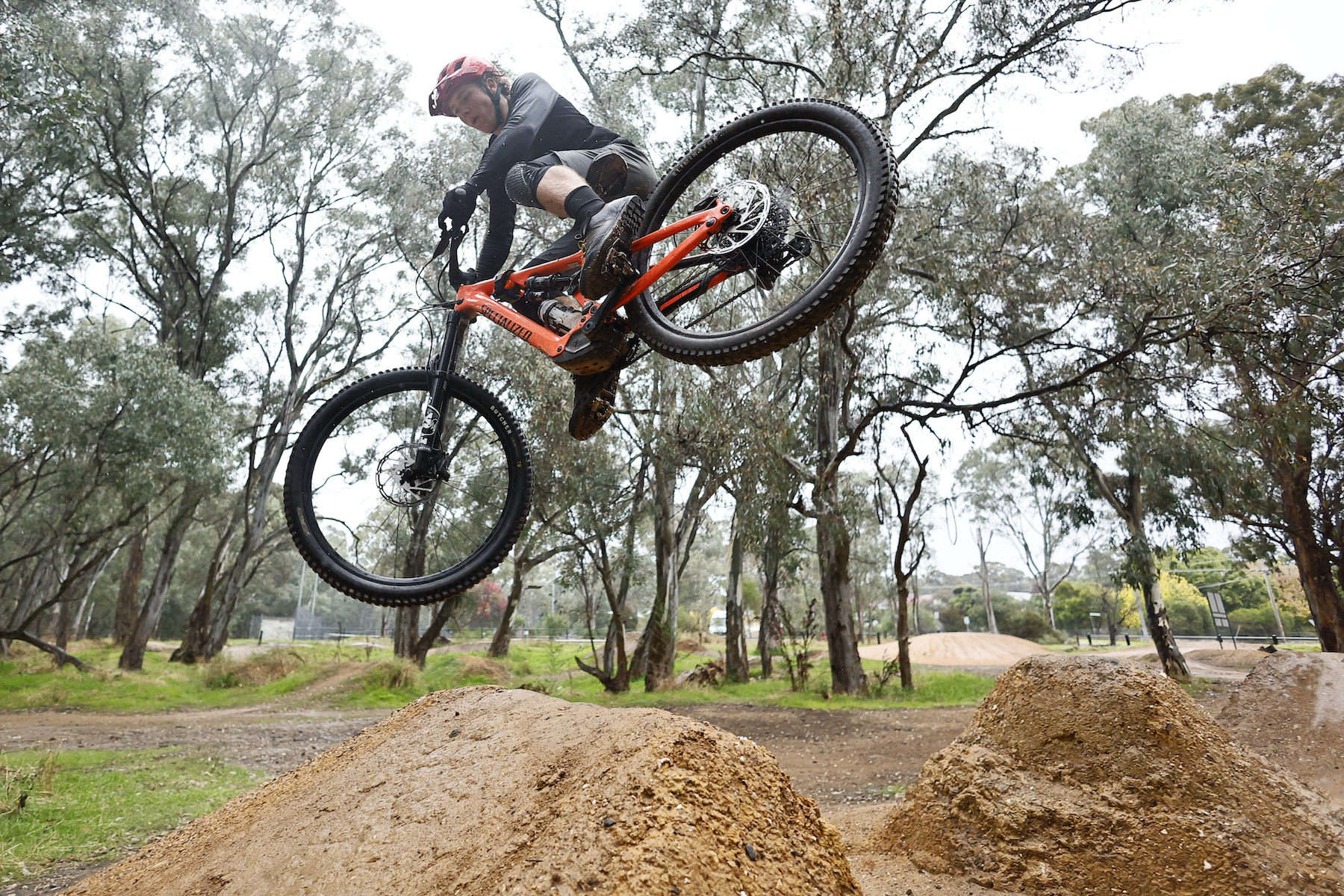
As with the motor, battery and suspension travel, there’s a lot of variance when it comes to e-MTB weight. To highlight that range, here is the lightest and the heaviest e-MTBs we’ve ever tested;
- Scott Lumen eRide 910 – 17.78kg
- Norco Sight VLT C2 – 25.32kg
Of course there are some significant differences between these two bikes.
The Scott Lumen is a lightweight e-MTB that’s designed around the compact TQ motor and a slim 360Wh battery. It only has 130mm of travel front and rear and it comes fitted with low-profile Schwalbe tyres. As a result it’s a very light, fast and agile bike that’s well suited to XC and trail riding.
In comparison the Norco Sight VLT features a full-powered Shimano EP8 motor, and our test bike came with the enormous 900Wh battery option. It has 160/150mm of travel, big brakes and heavy-duty Maxxis DoubleDown tyres that make it a highly capable bike for bombing steep and rowdy descents before self-shuttling your way back to the top.
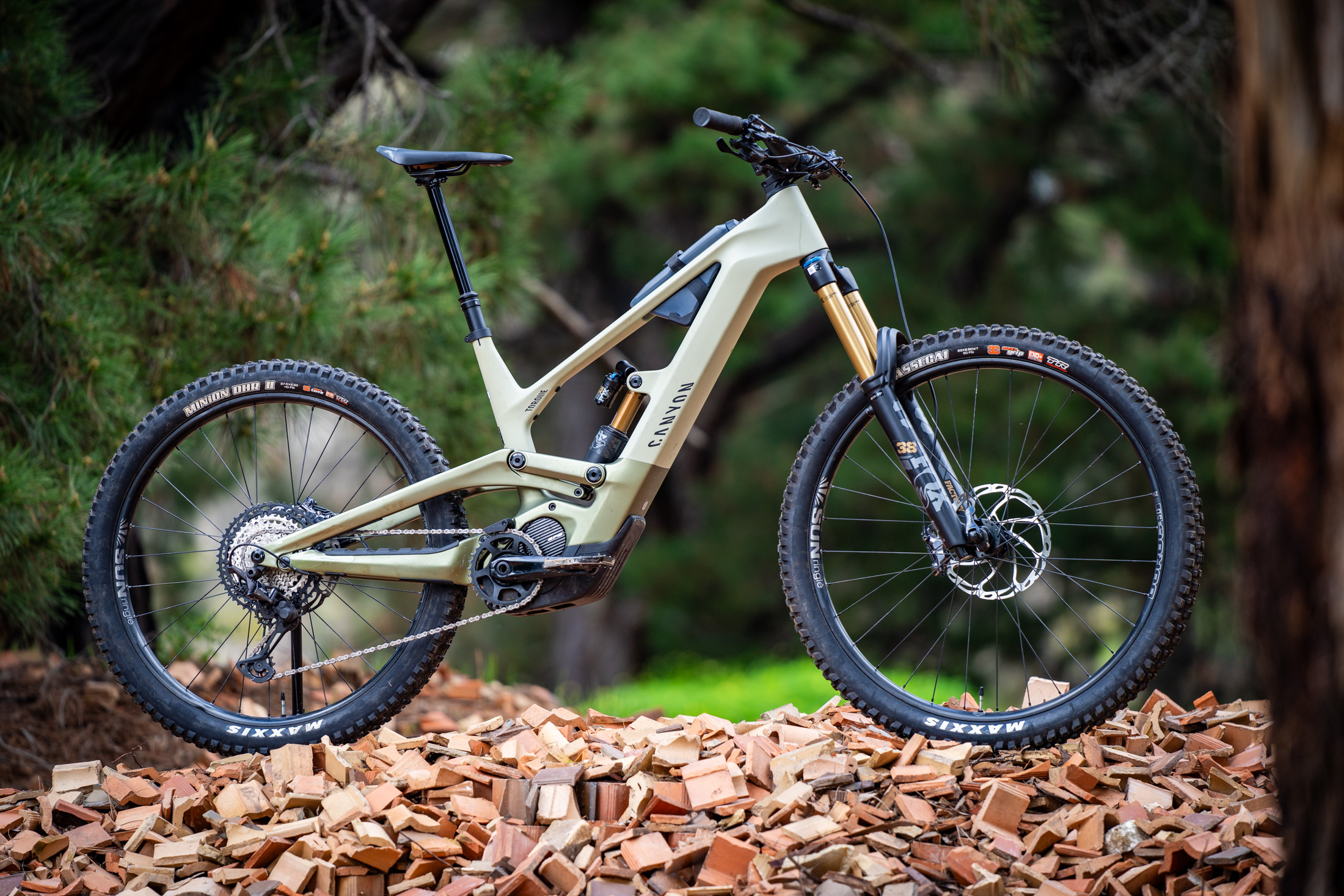
Sizing & geometry
Once you’ve decided whether you’ll be getting a full-powered or lightweight e-MTB, it’s important to think about what kind of riding you’ll be doing and how you want your bike to handle. Geometry plays a big role in this, with factors such as the head angle, reach, stack, chainstay length and BB height all affecting the bike’s handling and weight distribution.
Since geometry is tied closely with suspension travel, there are some generalisations that we can make. A longer travel bike that’s designed to excel on the descents will typically have a slacker head angle and a bigger wheelbase to maximise high-speed stability. In comparison, a shorter travel bike that’s made for all-round riding will have a steeper head angle and a tighter wheelbase to provide more agile handling.
Here are two examples to show the extremes at either end of the spectrum for a Medium-size frame;
- Orbea Rise (150/140mm travel) – 65.5° head angle, 450mm reach & 1,205mm wheelbase
- Canyon Torque:ON (180/175mm travel) – 63.5° head angle, 475mm reach & 1,276mm wheelbase
Every bike brand will list those figures in a geometry chart on its website, making it easy to compare with other options. This chart will typically come with a sizing guide that gives you recommendations for choosing the right frame size based on your height.
Getting the correct size is absolutely crucial to getting the best mountain bike experience, whether it involves a motor or not. If you’re unsure, speak with your local bike shop or contact the brand directly to see what they advise. Organise a test ride if possible. And if you’re right on the border between sizes, consider what you want to get out of the bike. If you’re after more stability and an upright riding position, it may be beneficial to upsize. If you prefer a more nimble ride quality, downsizing could be the better option.
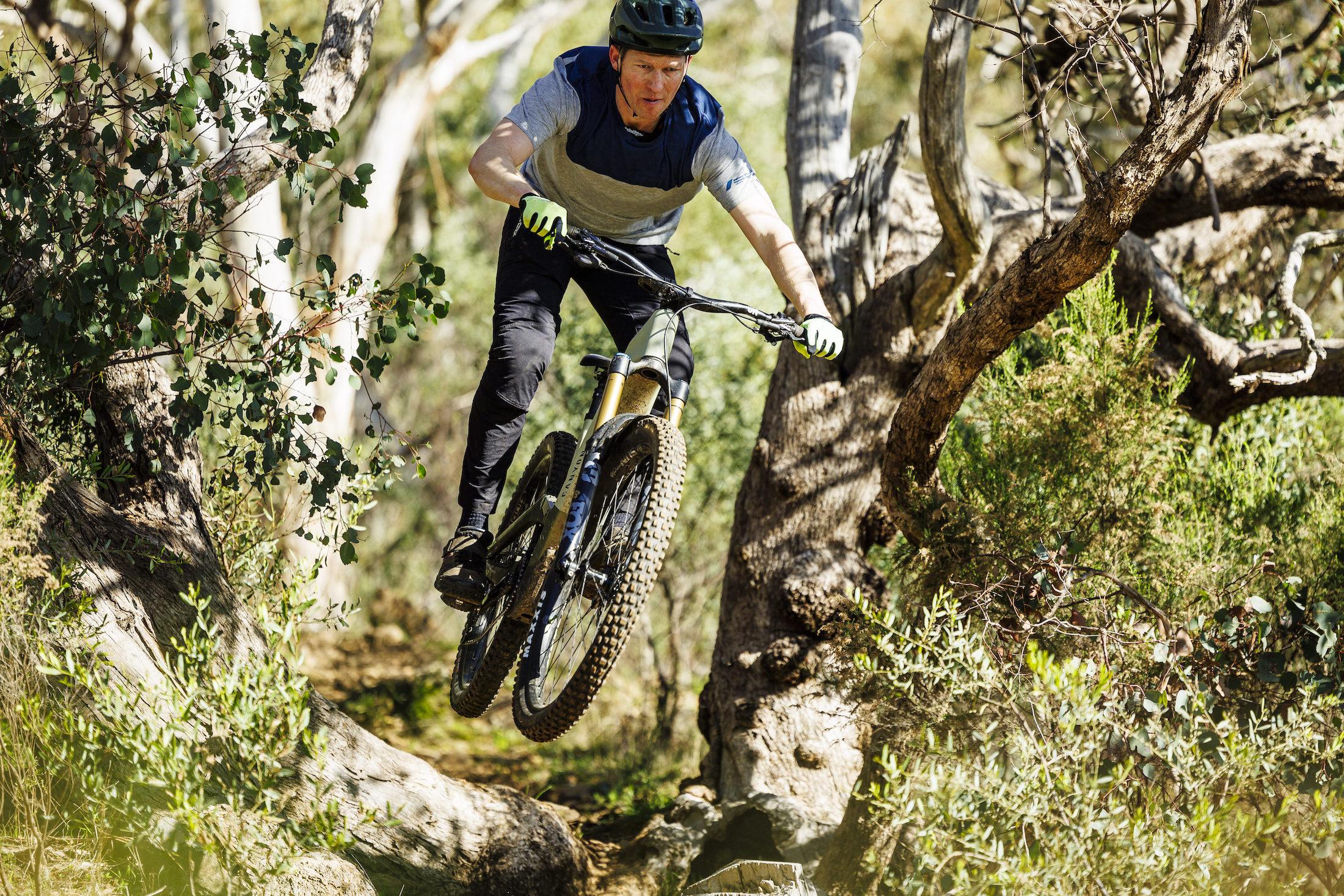
Mullet or full 29er?
Alongside geometry and travel, wheelsize is another important factor in the overall ride quality.
These days we’re seeing most new e-MTBs built around a dual 29in wheel setup that offers plenty of grip and stability, along with improved rollover that really helps on technical climbs. For longer-distance riding on undulating terrain it’s hard to look past a full 29er, especially for taller riders.
However, there’s a growing trend for ‘mullet’ bikes that feature a 29in front wheel paired to a smaller 27.5in wheel at the rear. As well as making it easier to initiate turns, the smaller rear wheel provides you with more clearance when pushing your weight back on a steep descent. It also allows bike designers to employ shorter chainstays that can benefit handling on twisty singletrack.
A great example of this is the latest Giant Trance X E+ Elite. By building the bike around a mullet setup, Giant was able to shorten the chainstays by almost 30mm compared to the 29in version. That’s a hefty difference, and it has a big impact in the ride quality on the trail.
- Giant Trance X E+ Elite (mullet wheels) – 447mm rear centre length
- Giant Trance X E+ (29in wheels) – 473mm rear centre length
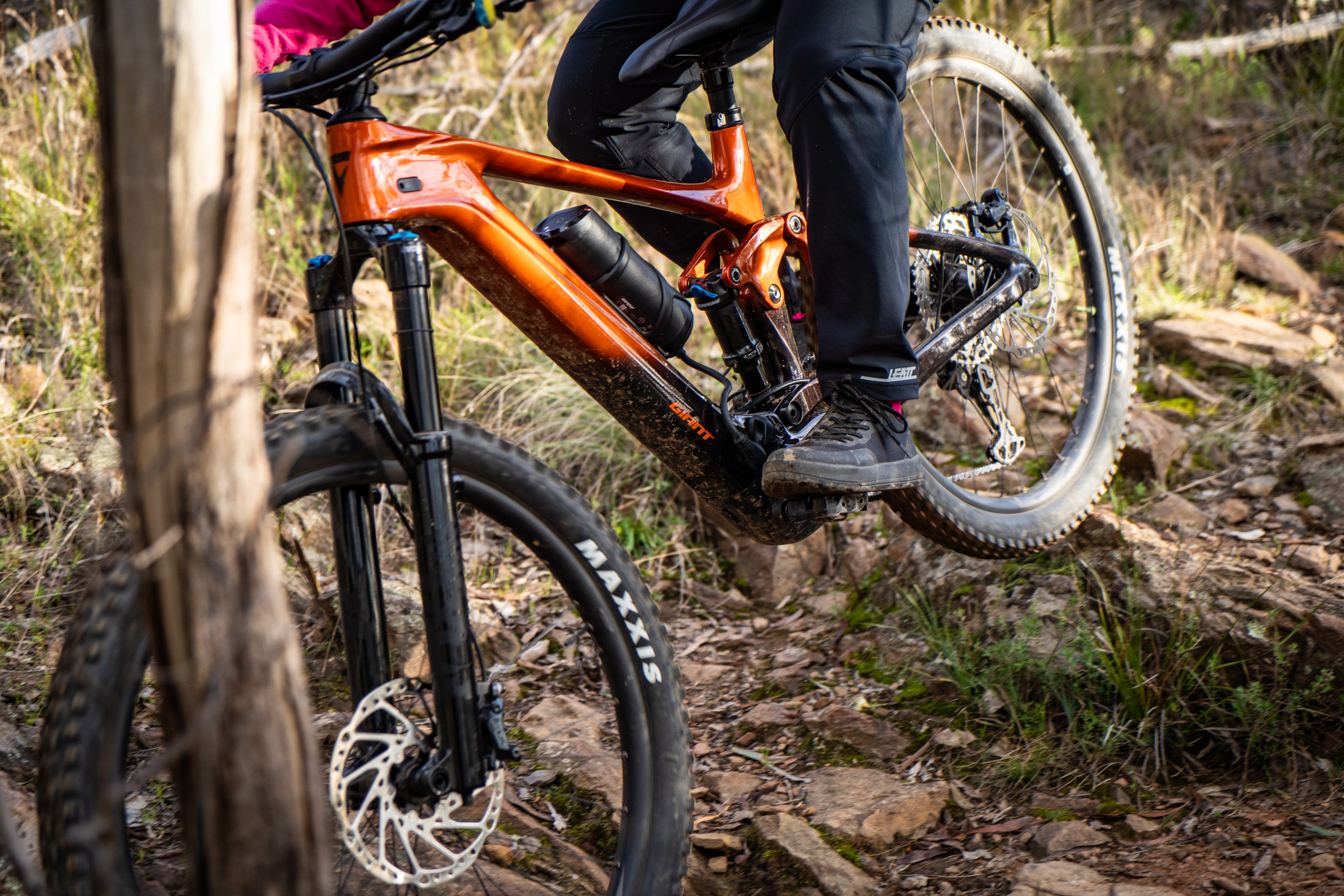
Since e-MTBs tend to be quite heavy, our general preference is for a mullet setup and the more agile handling it brings to the party. The smaller rear wheel might not offer the same grip and smooth-rolling performance as a full 29er, but for average-height riders we reckon a mullet is simply more fun.
The good news is that a lot of newer bikes coming out actually have the option to fit either a 27.5in or 29in rear wheel. These bikes will usually have some sort of flip chip to correct the geometry when switching between wheelsizes, giving you the option to experiment down the line.
Frame material | Alloy or carbon?
As with regular mountain bikes, most e-MTBs are offered in alloy or carbon fibre. Carbon is more expensive as it’s quite a labour-intensive material to construct with. Its advantage is that it can be used to make much more complex shapes compared to metal, and typically it results in a stiffer and lighter structure.
The difference in weight is really amplified on an e-MTB due to the larger diameters required for the downtube and motor casing area. In the case of the Canyon Torque:ON, the carbon frame is claimed to be a whole 1.5kg lighter than the alloy version. That is a huge difference!
It’s worth noting that you don’t always have the ability to choose. For example, the Polygon Siskiu T7E is only offered in alloy, whereas the Santa Cruz Heckler SL is exclusively produced in carbon.

Indeed most lightweight e-MTBs are made with a full carbon frame. And if weight is important to you, then it’ll likely be worth paying the premium.
If you’re not so fussed about weight, then an alloy e-MTB will cost you less. We also find we’re not as concerned by general scrapes and scratches with an alloy frame, which can occur a lot if you’re doing a lot of backcountry trail exploring on your e-MTB.
Components
We’ve touched on suspension, motors, batteries and geometry, but what about the parts strapped to an e-MTB? How important are they?
Starting off with one of the most crucial components, tyres can have a dramatic impact on the overall riding experience. Even lightweight e-MTBs weigh quite a bit more than their non-motorised counterparts, and that means they can build more momentum on the descents and slam into rocks and roots with greater impact force. As such, you really don’t want to be running lightweight tyre casings on an e-MTB.
The Scott Lumen is a notable example. That bike comes fitted with exactly the same tyres as the Spark, despite the Lumen weighing the same as a heavy-duty enduro bike. As a result we found the tyre casings were too thin and flimsy for riding rocky trails, and suffered from punctures unless we ran really high pressures.
Ideally you want a tyre with a thicker and more robust casing that’s going to stand up to the increased loads inflicted by an e-MTB. Climbing traction tends to be more important so you’ll want a fairly aggressive tread for the rear tyre, and a softer rubber compound up front is preferable to maximise grip. A good reference point is the excellent Maxxis Minion tyre combo on the Rocky Mountain Altitude Powerplay.

Tyre inserts are also worth considering. These days we run CushCore inserts on almost every e-MTB we test here at Flow, as they allow you to run lower pressures for more grip while drastically cutting down the chance of punctures and rim damage. Even if you’re not keen on inserts, we recommend getting yourself a proper digital pressure gauge and experiment with your tyres, as a few psi in either direction can make a big difference.
The wheels on an e-MTB also take an absolute beating. Ideally you want something that’s tough and durable, even if it weighs a bit more. DT Swiss actually makes a line of e-MTB specific wheels under the ‘Hybrid’ label, which feature heavier duty rims, thicker spokes, reinforced nipples, hubs with beefier bearings and a stronger freehub mechanism. We had great experience with those on the Canyon Spectral:ON CF 8.
Brakes are another crucial component to get right on an e-MTB. You want decent sized rotors front and rear, as they’ll help to reduce heat build up on long descents. If you’re after more power, you could always upsize the rotors to a larger diameter. Some frames and forks will accept 220mm rotors, which are about as big as you can go. Brake pads with a metallic compound can also help to mitigate fade, especially if you’re shuttling laps at a bikepark.

Cranks are another regularly abused component on an e-MTB, and for that reason we prefer alloy over carbon. Either way, it’s a good idea to fit crank boots to help shield the ends from rock strikes. Crank length is also important for ground clearance, and it’s why we’re seeing 165mm crank arms become increasingly popular on stock bikes. Some brands are going even shorter than that, as the extra millimetres of clearance can make a big difference to technical climbing.
There have been notable developments in e-MTB drivetrains of late too. Shimano’s Linkglide drivetrain is designed to handle the increased torque inflicted by modern motors, offering improved shifting under load and three times the durability of a conventional chain and cassette. We had excellent experience with the 10-speed Linkglide drivetrain on the Liv Embolden E+, and found no problem with having a slightly smaller cassette ratio.
SRAM’s new Transmission is also becoming more prevalent, and for good reason. The shift performance works exceptionally well on an e-MTB like the Specialized Levo Pro, and in our experience the direct mount derailleur design is far tougher. It certainly doesn’t come cheap though.

Buying online, or through a shop?
There’s an increasing number of brands that allow you to purchase e-MTBs online, with Marin, Polygon and Canyon being the main ones that we have experience with.
The most appealing part of buying online is that you’ll typically get a cheaper price compared to buying through a shop. However, you will need to partially assemble the bike and set it up on your own.
If you’re not mechanically inclined, you may be better off buying through a local bike store. A shop usually provides an opportunity to take bikes out for a test ride, either off-road or just around the carpark to at least to confirm you’re getting the right size. Your e-MTB will then be built by a mechanic, and in most cases the staff will take you through the suspension setup process to make sure it’s dialled in before you hit the trails.
It’s not that we don’t recommend buying online. Indeed tech-savvy customers who can do all their own mechanical work at home will likely appreciate the experience of having a bike delivered straight to their door. Most online brands have a great of resources to help
Of course you can still take a bike that you purchased online into a local shop to have them perform repairs as needed, you’ll just have to be prepared to pay for that service. The same goes for warranty support. Most shops will be able to assist you if you encountered a warranty issue with a Shimano motor for example, but they’ll still need to cover the necessary labour costs involved in the repair.

Adjustability & upgrade options
If you’re planning to own your e-MTB for a good few years, it’s worth thinking about what adjustability you might want built into it. We say this because making a few choice upgrades can be a great way to adapt the ride quality without you necessarily having to shell out for a whole new bike.
Finding yourself riding steeper and more technical trails? Most frames on the market have the ability to run a longer travel fork than they come supplied with. We did exactly this in our long-term review of the Trek Fuel EXe, extending the fork from 150mm to 160mm of travel, which had a thoroughly positive effect on its descending capabilities.
Some e-MTBs are even compatible with a coil shock, which could be a goer if you were chasing a plusher ride quality.
Many frames will also have a flip chip built in for adjusting the geometry. These typically provide you with a high setting that lifts the BB and steepens the head angle, and a low setting that drops the BB height and slackens out the head angle.
The Specialized Kenevo SL even has a flip chip integrated into the chainstay suspension pivot, which provides you with short and long settings for tweaking the handling. You can alter the rear suspension’s progression with the clever Ride-9 shock mount on the Rocky Mountain Altitude Powerplay, while the Scott Lumen allows you to adjust its head angle independently from the rest of the bike via its modular headset cups.
Of course not every rider will be interested in all of these geometry-altering bells and whistles. If you feel like they’re just adding complication, then there’s no point in paying for those features. But if you like the idea of being able to experiment with your bike setup in the long-term, then it’s well worth looking at what tuning options are available with your new bike.
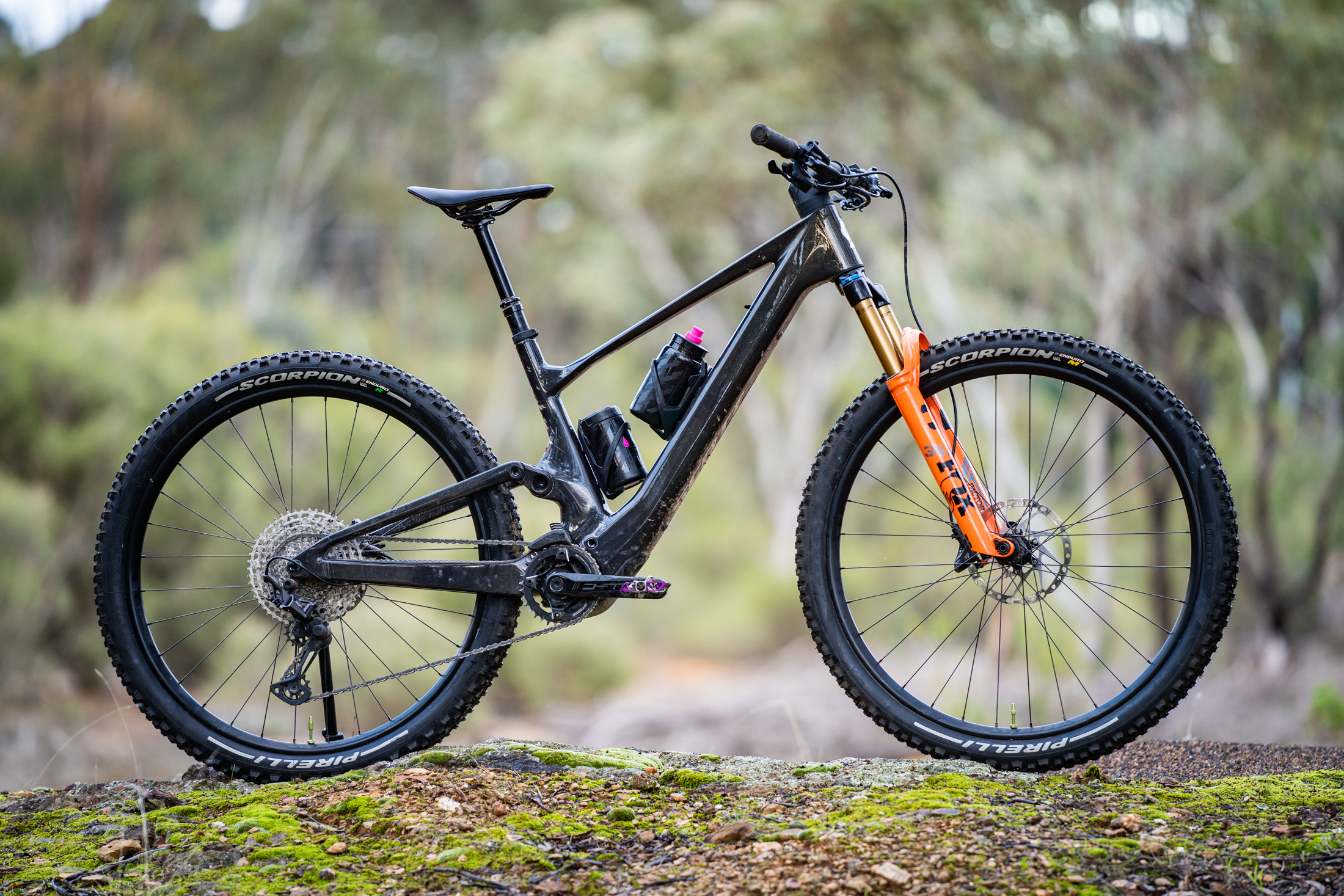
e-MTB reviews
Last but certainly not least, search out reviews on the e-MTBs you’re looking at.
There are loads of great folks out there who are testing bikes and providing useful information that can help you with your purchasing decision. Those reviewers may uncover issues that could make a particular e-MTB an absolute dealbreaker for you, or they might simply cement the fact that it’s going to be ideal for your riding style.
For us here at Flow, we always like to approach our reviews as if we owned the bike ourselves. Would we be happy with the money we spent on it? Is there anything that concerns us in regards to servicing or long-term durability? What upgrades would help to unlock further performance? Is there anything else at this price point worth considering?
If you’re keen to see how the latest bikes stack up, be sure to check out our extensive list of e-MTB reviews.
